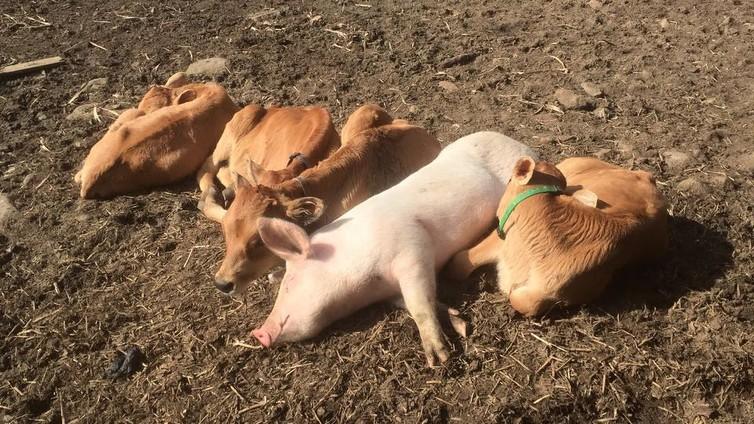Hugs, drugs and choices: Helping traumatized animals
Rosie the anxious pig likes to sleep with bobby calves at Sugarshine animal sanctuary.
Rosie, like a real-life Babe, ran away from an organic piggery when she was only a few days old. She was found wandering in a car park, highly agitated, by a family who took her home and made her their live-in pet. However, after three months they could no longer keep her.
She was relocated to the Sugarshine animal sanctuary, outside Lismore in New South Wales. Kelly Nelder, Sugarshine’s founder and a mental health nurse, described her as “highly strung” and “needy.” It’s not surprising that Rosie, after the loss of two primary care attachments, was unable to bond with the other pigs; she was traumatized.
I met Rosie when I visited Sugarshine, investigating the similarities between human and animal trauma. I spent 20 years as a clinical and forensic psychologist, but as an undergraduate I studied zoology.
My zoology lecturers told us not to anthropomorphise – that is, not to project human qualities, intentions and emotions onto the animals we studied. But now there is a growing recognition of animals’ inner life and their experience of psychopathology, including trauma.
At Sugarshine, traumatized animals are given freedom to find solitude or company as they wish. Interspecies relationships are encouraged, like a baby goat being cared for by a male adult pig, or a rooster who sleeps alongside a goat.
Rosie has been at Sugarshine for a few months now and is more settled, roaming its gullies, farmyards and shelters, although according to Kelly she’s still anxious. She prefers the company of the bobby calves, wedging herself between them as they lie on the ground, getting skin-to-skin contact, falling asleep, and beginning the reattachment process.
oembed://https%3A//www.youtube.com/watch%3Fv%3DIbNNwIZUsDo%26feature%3Dyoutu.be
Understanding trauma in animals
I first made the connection between human and animal trauma on a visit to Possumwood Wildlife, a center outside Canberra that rehabilitates injured kangaroos and abandoned joeys, wallabies and wombats. There I met its founders, economics professor Steve Garlick and his partner Dr. Rosemary Austen, a GP.
When joeys were first brought into their care, Steve told me, they were “inconsolable” and “dying in our arms,” even while physically unharmed, with food and shelter available to them.
But this response made sense once they recognized the joey’s symptoms as reminiscent of post-traumatic stress disorder in humans: intrusive symptoms, avoidant behavior, disturbed emotional states, heightened anxiety and hypervigilance.
Researchers at the University of Western Australia have developed non-invasive means for measuring stress and mood in animals and are now working with sheep farmers to improve the well-being of their animals. PTSD has been identified in elephants, dogs, chimpanzees and baboons, for example.
Safe, calm and caring
To rehabilitate from trauma, humans and animals need to feel safe and away from cues that trigger the individual’s threat response, deactivating the sympathetic nervous system (the fight-flight response). They also need a means of self-soothing, or to gain soothing from another, activating the parasympathetic nervous system (the rest, digest and calm response).
Progress, from then on, requires the development of a secure relationship with at least one other accepting and caring person or animal. Often, this “other” is someone new. In mammals, including us, this activates our affiliative system: our strong desire for close interpersonal relationships for safety, soothing and stability. We enter a calmer, receptive state of being so that the reattachment process can begin.
Possumwood uses three stages for trauma rehabilitation. Young animals are first kept in a dark, quiet environment indoors to reduce noises or sounds that might trigger their fight-flight response. Here they have the opportunity to develop new kin friendships of their own choosing.
Sedatives (diazepam and fluphenazine) are judiciously used in the early stages. Then, the principal carer spends as much time as possible feeding and caressing them to build a new bond.
Kangaroos are social animals, unable to survive in the wild unless part of a mob. So joeys are moved next to a large garage, and then finally to an outdoor yard, gradually being exposed to more kangaroos and creating social bonds. Once a mob grows to 30 or so healthy animals, they are released into the wild together.
The fundamentals are the same
The similarity between animal and human trauma is not surprising. Mammalian brains (birds also appear to experience trauma) share the principal architecture involved in experiencing trauma. The primates, and certainly humans, have a greater capacity for cognitive reflection, which in my clinical experience can be both a help and a hindrance.
My observations of trauma rehabilitation at Sugarshine and Possumwood emphasizes the universal fundamentals:
- A sense of agency (freedom and control over their choices).
- To feel safe.
- To develop a trusting, caring bond with at least one other creature.
- Reintegration into the community at the trauma sufferer’s own discretion.
For those experiencing social isolation and shame around their trauma — such as returned soldiers or the victims of domestic violence — these principles could not be more pertinent. And for our non-human cousins, like Rosie, we would do well to remember that they do feel, and they do hurt.
This story was originally published at The Conversation.
Our coverage reaches millions each week, but only a small fraction of listeners contribute to sustain our program. We still need 224 more people to donate $100 or $10/monthly to unlock our $67,000 match. Will you help us get there today?
